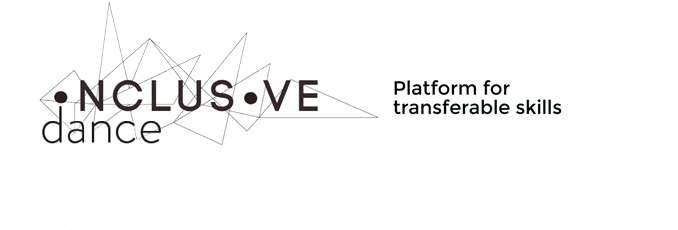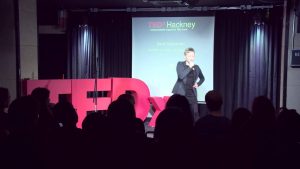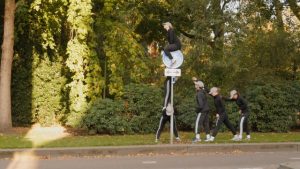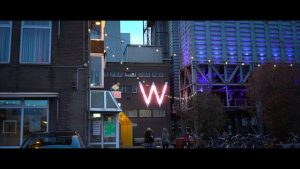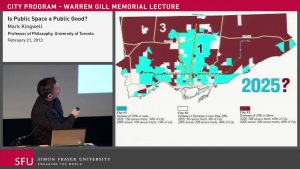by Veronika Simkova
Anna Sedlačková has been a dancer, choreographer and teacher for more than 30 years. She graduated from The Academy for Performing Arts is Bratislava in 1987. Since then she has deepened her dance performance studies in various artistic and educational programs in Slovakia and abroad. She has created an experimental space in the Dance Department of Academy of performing Arts in Bratislava. She has also collaborated with European Dance Development Center in Arnhem, Holland and received Fulbright scholarship, for research at Hampshire College in the USA. Anna Sedlačková started to be engaged in Body – Mind Centering studies from summer 2000. In 2006 she graduated as an IDME – Infant Developmental Movement Educator, in 2007 as SME – Somatic Movement Educator and in 2013 as Body – Mind Centering Practitioner. In 2006 she defeated her ArtD. theses, Development of movement in system Body – Mind Centering and its application in dance education.
“Body – Mind Centering is system established by Bonnie – Bainbridge Cohen and explores how is mind expressing through the body. Through the embodiment of systems of the body as well as the process of development. In 2004 me and my friend Angelika Kováčová established organization Babyfit. During 12 years we organized not only movement classes for babies and parent but also educational program in somatic approach to developmental movement and certified program of the School for Body – Mind Centering. In 2013 – 2015 we took part in cross – cultural exchange and learning project SPARKS which explored somatic approach of BMC in the field of people with special needs,“ says Anna.
How did you get to the Body – Mind Centering method?
In 1994, I was selected for a residential stay in the USA, called Artslink, organized by the Soros Foundation of Contemporary Art. I spent 6 weeks at different places in the States (New York, Washington DC, Lincoln – Nebraska, New Orleans – Mississippi). My host organisation the “Wagon Train Project” was based in the town of Lincoln, which is the capital of the state of Nebraska.
I met Marta Renzi, a famous choreographer of the New York alternative dance scene there. It was under her guidance that I carried out the project entitled “Prodigal Daughter”. We realized we shared a lot in common and started intense collaboration. Between 1995 and 1998 we danced together intensely, it was in the USA, then in Slovakia, in the Czech Republic and in Austria. In 1996, we were preparing a project on a residential farm belonging to Aat Hougée, the director of the European Dance Developmental Centre (EDDC) a school in Arnhem, in the Netherlands. I got most interested in the school and managed to create closer contacts both within the school and also personal ones. In 1998, I created a project for EDDC and decided to invest the money received for it in my education. I liked the study program in the School for Body – Mind Centering, so I enrolled two system courses (skeleton and organ systems) and left for the USA. I assumed the course content would be similar to dance education. The BMC approach to learning surprised me just as all it may involve, how questions are more important than answers, how to cope within relationship. It changed my view on learning, art and life completely.
What is such a class like?
That is a good question. BMC is an open approach offering a very strong tool which is one’s own experience. Personal experience from certain aspects of a selected body system, movement development or embryological process. The principles of BMC draw on collective experience of a number of people and they have multilayered manifestations, reflecting movement analysis, anatomic, physiological, psychological and spiritual aspects.
To be specific: the theme of the class is reflexive movement as a constituent part of a developmental process. One part of the class consists in theoretical approach to the theme, relying on anatomical knowledge as much as on developmental psychology. Thereafter, we will observe the form of certain reflexes and means to stimulate them. It may then be followed by a partner exercise, alternatively concentrating on the roles of the stimulus recipient and the stimulus donor. Having exchanged the roles, the pair or a whole group verbally share their experience. The next part may be devoted to employing the subject in professional practice of e.g. a therapist or a dancer, etc. The conclusive part is devoted to the integration of certain forms of creative processes, for instance to drawing, dance, modelling, creative writing and others. This is an important moment for saving the new information into centers in the brain sub-cortex so that cortex (as Bonnie Bainbridge Cohen claims) is available for imagination and inspiration.
Do you use dance or other somatic approaches in your classes?
It is easy for me to perceive the continuum of somatic and research work with dance technique, stage dancing or daily life. I have found out that this is not everybody’s case though, thus I learn to relate to the separation of information and styles. But I am not very good at it.
I get very easily enthusiastic about my somatic experience, so I often share it in my teaching. Transformed, it often becomes part of my teaching style.
For example, certain aspects of the Feldenkrais method, ideokinesis, contact improvisation, dance are definitely woven into my ways of teaching BMC.
What is the sense/aim of Body – Mind Centering method?
In my view, it is through deepening attention on sensing and feeling and action, gradual acceptance of one’s self. BMC teaches possible ways of extending possibilities to react differently to a particular situation and that relates to understanding our joys but also hardship.
Is it your profession or is it only a supplement to your profession of a dancer / dance teacher?
It is both for me, I employ the method and principles of BMC in dance, those making sense in a particular situation. While working with children or adults, as a BMC therapist I also use my dance experience.
How did you imagine your dance carrier before entering a dance school? What was so attractive about being a dancer?
It was most exciting for me to think about my life related to dance. What’s more, as for an artistic life, I could only imagine it because I did not have any real experience. Creativity, movement, anticipated relationship with people – that was what enthused me.
I was attracted by the variety and change in life which I imagined.
How did this image of future carrier evolve during your school years?
It’s been a long time, but let me think. When studying, I had the feeling that my future is planned beforehand. I studied dance pedagogy so, just as everyone else before me, I thought I would graduate and start teaching. There existed no real possibility of an active dance career in modern dance.
Having graduated, paradoxically, there began to open an area of independent artists, groups and projects, bringing about a possibility to define yourself as a dancer, still an ongoing process in my case.
What comes up in connection with how I imagine my career is realizing the fact that I have a certain limit of exhaustion beyond which my joy of dancing disappears. On the other hand, I have recently assured myself that dance is inevitable for me, a part of my being.
Has anything shifted again thanks to the Body – Mind Centering method?
Certainly and a lot. BMC encouraged me to take responsibility for my life. It taught me to be able to say “no”. It teaches me to recognize my needs to perceive different places and states of my mind. It helped me get to know “normal” people through work with children and their parents, to see their joy and sorrow. Conversely, this helped me notice simple themes for dance. I enjoy bringing dance and personal interest through dance to “normal” people. It teaches me to understand “normal” people.
Is the content of your class or the way of leading it nurtured by your active profession as a dancer?
I think that I teach best after having performed. Then the reason why I teach is obvious. A performance invites us to visit spaces we can’t enter in our daily lives. It gives us the space to be seen, to be transparent, to invite the audiences to ask, to discover, to fly. Coiled dimensions develop.
